Launched in 2018 as part of Service Hub, HubSpot’s Knowledge Base has come a long way. What started out as a very minimal product is now at a point where it is almost fully featured. This post gives an outline of how the product has matured from its infancy to today, as well as tips on how to evolve a product into the most valuable version of itself.
Use an MVP as the Starting Point
Like any new product at HubSpot, our first release was very much a Minimal Viable Product (MVP). At its core, a knowledge base should do two things:
- Allow users to publish answers to their customers’ questions online
- Allow customers to be able to find answers to their questions online
Our aim for the MVP was to allow our customers to do these two things as simply as possible.
The MVP consisted of:
- A simple editor, providing users with a focused writing experience
- Article categories to provide information architecture
- Basic insights (article views) to allow users to see the value that it was providing to their customers
- Basic design (colors and logo) to allow users to align the knowledge base with their brand
The MVP was well received by our early customers, with many launching their knowledge bases within a couple of weeks, but one common question we would hear from prospects/customers was, “Why would I use a Knowledge Base instead of a Blog or Website Pages?”
It was a fair point — we had grand plans for the future of this product, but as it stood, our customers could not see its value.
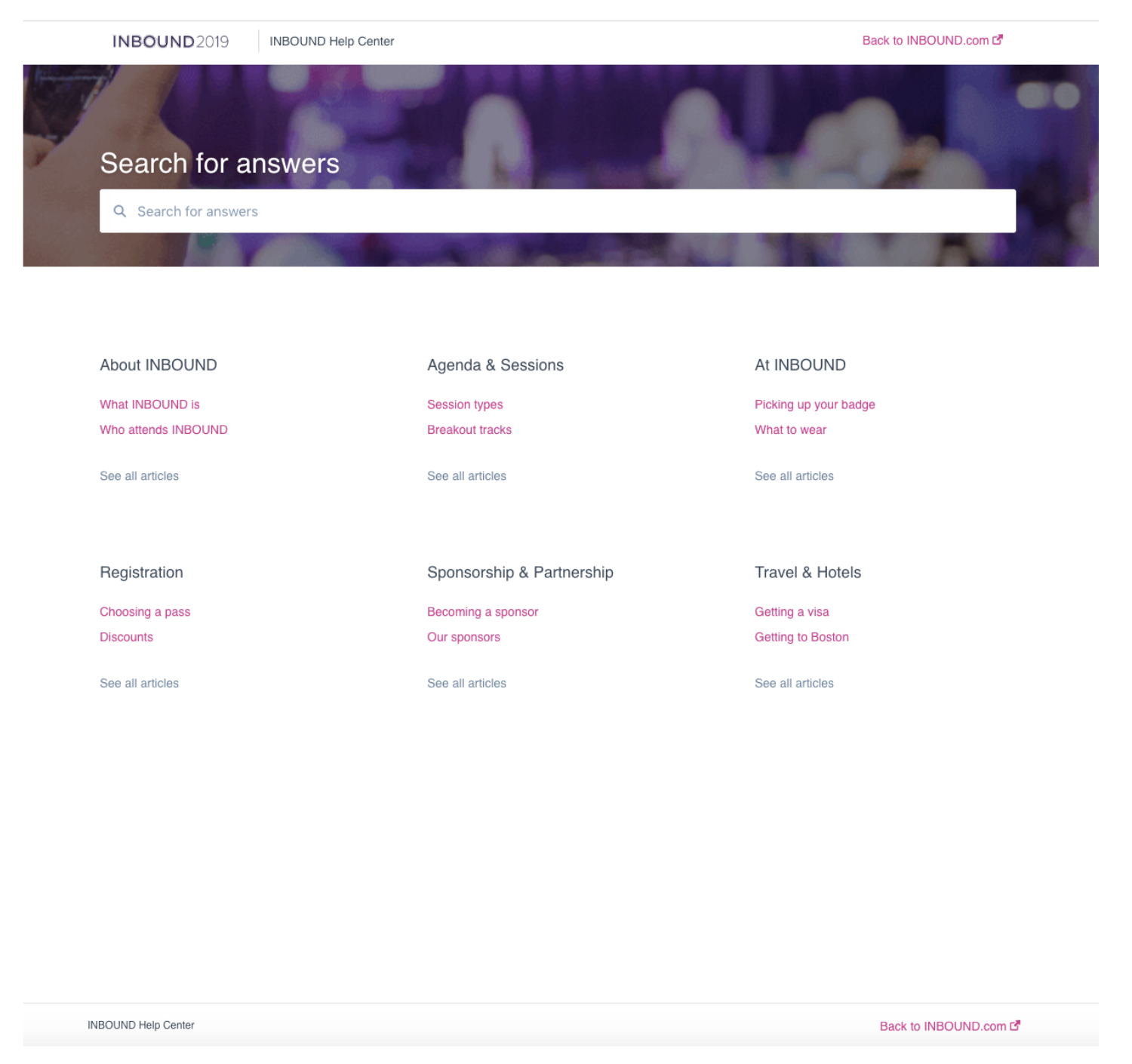
Inbound Help Center was the first live knowledge base (We love to eat our own dog food)
Differentiate the Product
The next step was to really address this question and differentiate Knowledge Base from our other content products. We decided to address this question in two ways:
- Double down on article categories
- Deliver key insights that would improve the performance of a knowledge base
Double down on article categories
The information architecture of a knowledge base plays a huge role in its performance and the value that it provides to end customers. Most of the time when customers land on a knowledge base, they’re trying to troubleshoot an issue they’ve run into. They can be stressed and under time pressures — the quicker they find their answer, the better an experience they’ll have.
Categories play a key role in optimizing the browsability and findability of answers in a knowledge base by grouping together related articles. We decided to double down on helping our customers visualize this information architecture and providing an easy way for them to adjust it. We achieved this with the release of the drag-and-drop organize editor.
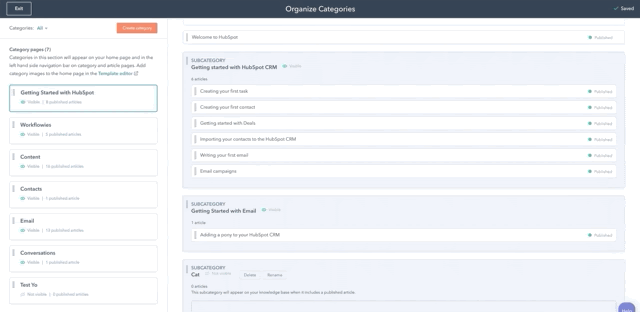
Drag and Drop Organize Editor
Deliver key insights
We wanted to deliver insights that really matter to our users to help them understand what areas of the Knowledge Base add value to the customer and what areas need to be improved. The insights that we decided to focus on were:
Article Health
Demonstrating the value of a knowledge base can be tricky. Unlike in marketing content, there is no conversion point such as filling out a form, clicking a CTA, or subscribing. Ultimately, value is provided if the customer has solved their problem. To demonstrate value, we added a feedback module to each article allowing customers to indicate if they found an article helpful or unhelpful. This not only contributed to demonstrating value, but it also surfaced articles that needed to be improved. All of these feedback insights are presented to users in the Article Health report. The report appears front-and-center in Knowledge Base to encourage users to track these important insights.
Search Insights
The second insight we delivered focused on search. We wanted to show our users what their customers were searching for and highlight the search terms that were not delivering helpful information. This insight has been hugely successful for encouraging customers to create new content for weak areas of their knowledge base.
By focusing on these two areas, our customers now realized the benefits of publishing help articles on the Knowledge Base as opposed to publishing this information on a blog.
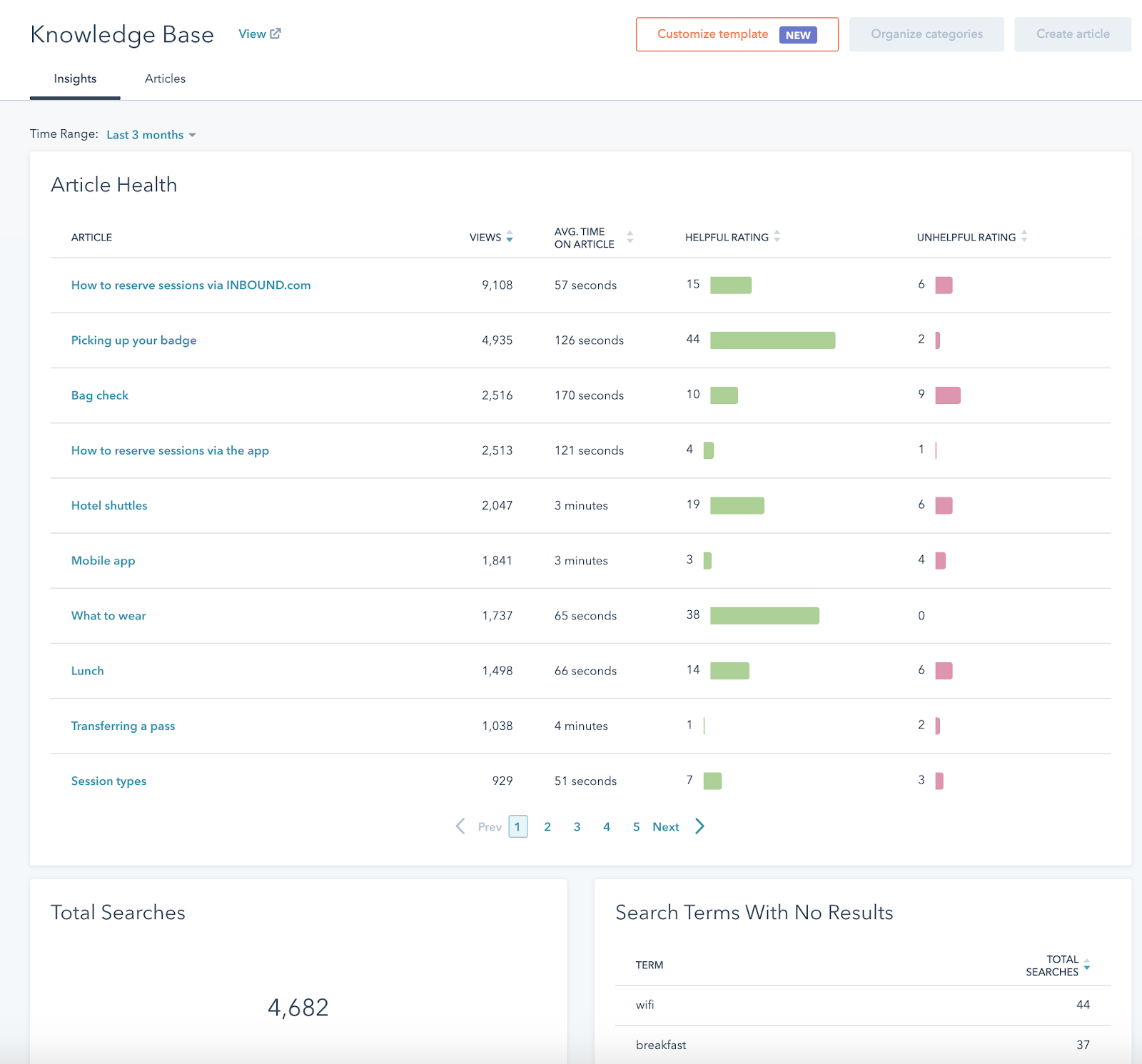
Knowledge Base Insights
Improve Adoption
With our customers now understanding the value of the Knowledge Base, the next area we wanted to focus on was adoption. We spoke to countless customers, as well as internal teams within HubSpot (such as Implementation Specialists and Sales and Support), to figure out the roadblocks early on in the adoption process. We found there were two main barriers to people adopting the Knowledge Base:
- Moving over from an existing knowledge base was time-consuming and this was delaying adoption.
- Many users were fearful of their competition having access to their help content and only wanted their customers to have access to it.
Import
We tackled the migration issue by introducing an import feature allowing users to import a knowledge base from the most popular platforms in just two clicks. Users can now simply enter the URL of their existing knowledge base and we handle the rest.
Restricted Access
For the second issue, we extended the new Content Membership feature to Knowledge Base. This allows businesses to securely share their help content with their customers.
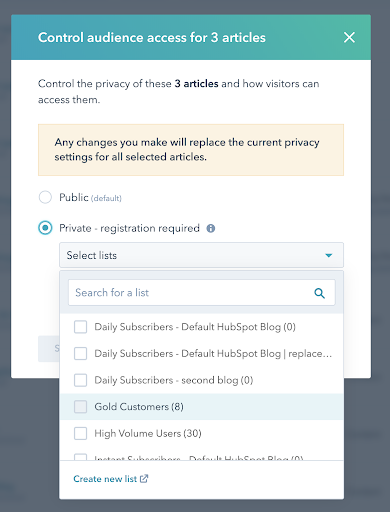 Controlling access to Knowledge Base articles
Controlling access to Knowledge Base articles
Clean House
At this stage, our adoption numbers increased — we had removed two big roadblocks for our users. We decided to take a breather from building features and instead focused on improving what we already had. We spent a substantial amount of time improving the performance of the entire product — in particular, the Organize and Insights screens. As well as improving performance, we also spent a lot of time digging into our users’ biggest pain point: the article editor.
Rebuilding the Article Editor
Unsurprisingly, writing articles is where our users spend most of their time in Knowledge Base. For quite a while, we had been hearing about different areas in this experience causing our users pain. Examples include users being unable to:
- Paste images into the editor
- Indent items in lists
- Add images to ordered lists
- Add code formatted areas
- Embed 3rd party videos
- Add tables
- Add anchors
Given the amount of pain that our users were experiencing, we took a long, hard look at our editor stack and evaluated whether we should persist with our current stack or move toward a more mature stack that would eliminate a lot of these pain points. In the end, we decided to make the change and moved from Draft.js to TinyMCE. We completely rebuilt the editor from the ground up, moving toward an editing experience more consistent with other content tools within HubSpot. Moving to TinyMCE eliminated a lot of these issues.
Taking the Writing Experience to the Next Level
We wanted to build upon this new foundation and focus on some natural next areas of improvement. Our users were happy with the improved editing experience but there were still some outstanding issues that had to be solved:
- Tables
- Anchor links
- Code formatting
- Highlighting
Over time we added these features to the editor, creating new experiences for tables and anchors as well as introducing callouts to allow writers to highlight important areas to their readers.
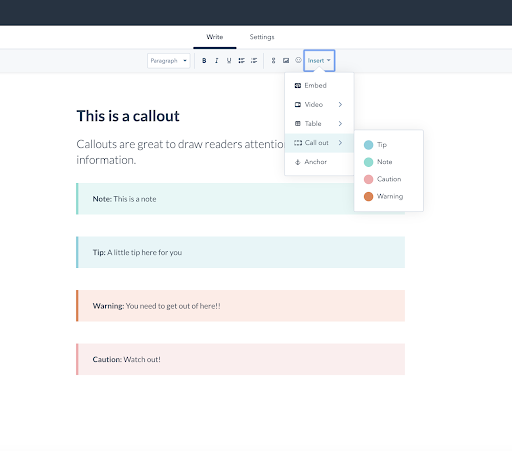 Callouts help to highlight important areas of an article
Callouts help to highlight important areas of an article
Improving Design Options
From day one, one of our users' biggest pain points had been the lack of design control. Many users were frustrated that they were unable to represent their brand on the Knowledge Base in a way that was consistent with their website. We repeatedly heard users express a need to choose fonts and their own imagery for categories.
When digging in deeper with our users, many presented us with a design they had in mind for their knowledge base. After a number of interviews, some very clear patterns began to emerge. For example, a very common template we saw was the Tiles pattern used on many company help pages, such as the Slack Help Center.
Thinking through how to solve this problem, we considered simply opening up Knowledge Base’s template code. But we saw that a large proportion of our users didn’t possess the skills needed to create a beautiful knowledge base through coding. Opening up the code at this point would leave a lot of our users behind.
We set about creating an experience that would allow any user (technical or nontechnical) to implement a beautiful knowledge base in minutes by giving them all of the popular Knowledge Base templates straight out of the box. This new experience was released as Customize Template in October 2019.
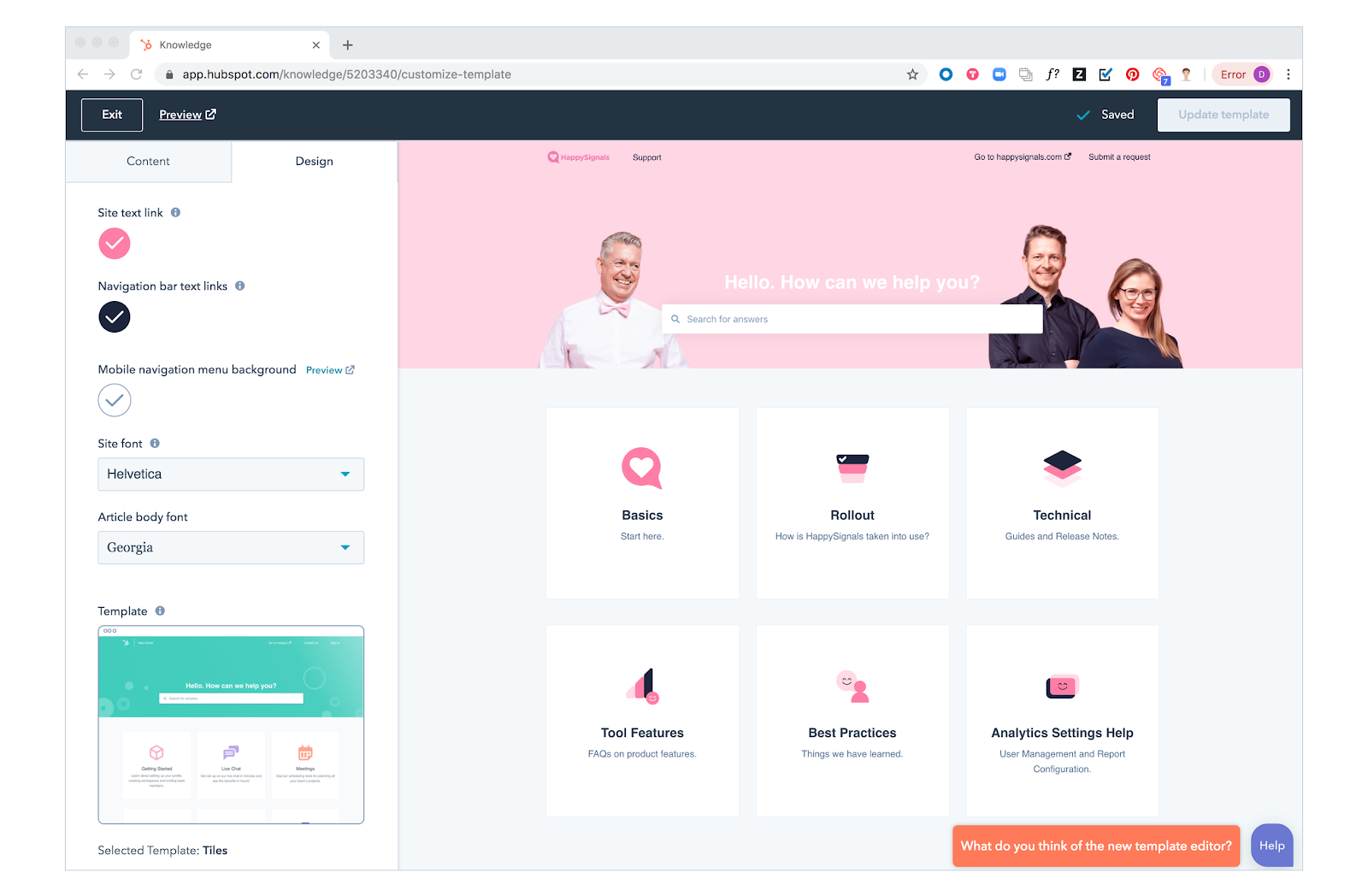
Template editor using Tiles design
Acknowledge That No Product Is Ever Finished
The release of the new template experience was a complete game-changer for the product. Larger businesses that had once passed on using the Knowledge Base were now adopting the product in high numbers. But of course with larger businesses come new problems to solve. These large businesses have more complex needs. They want to be able to support their customers in multiple languages, support multiple brands within their business, and have developers and designers that want full design control over the look and feel of their knowledge base. Solving these more complex needs is where we are headed next. Quite recently we released a multiple language feature and in the not too distant future, we plan on solving more of these large business problems.
Creating the Knowledge Base product from scratch alongside a fantastic team of engineers and designers has been one of the most enjoyable experiences of my career and the most exciting thing is that we are just getting started. No product is ever finished and Knowledge Base certainly has a lot more runway!
